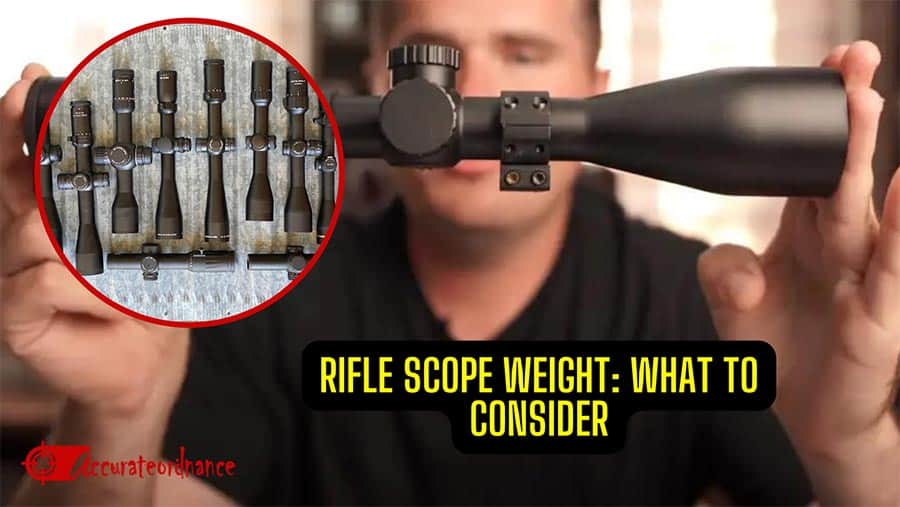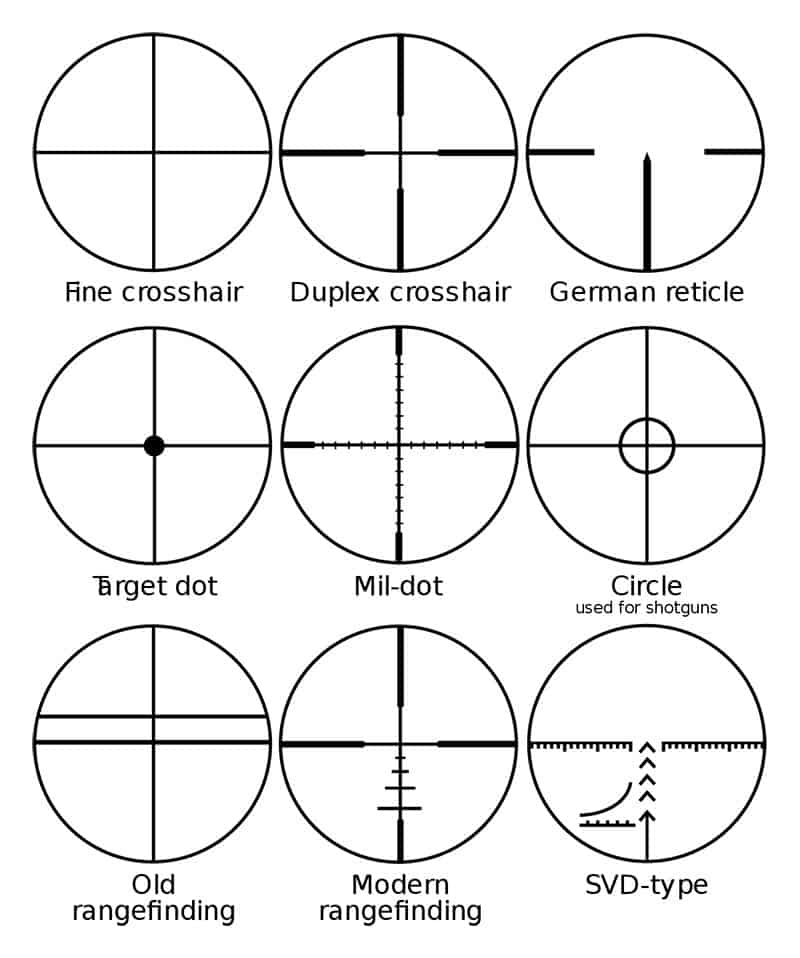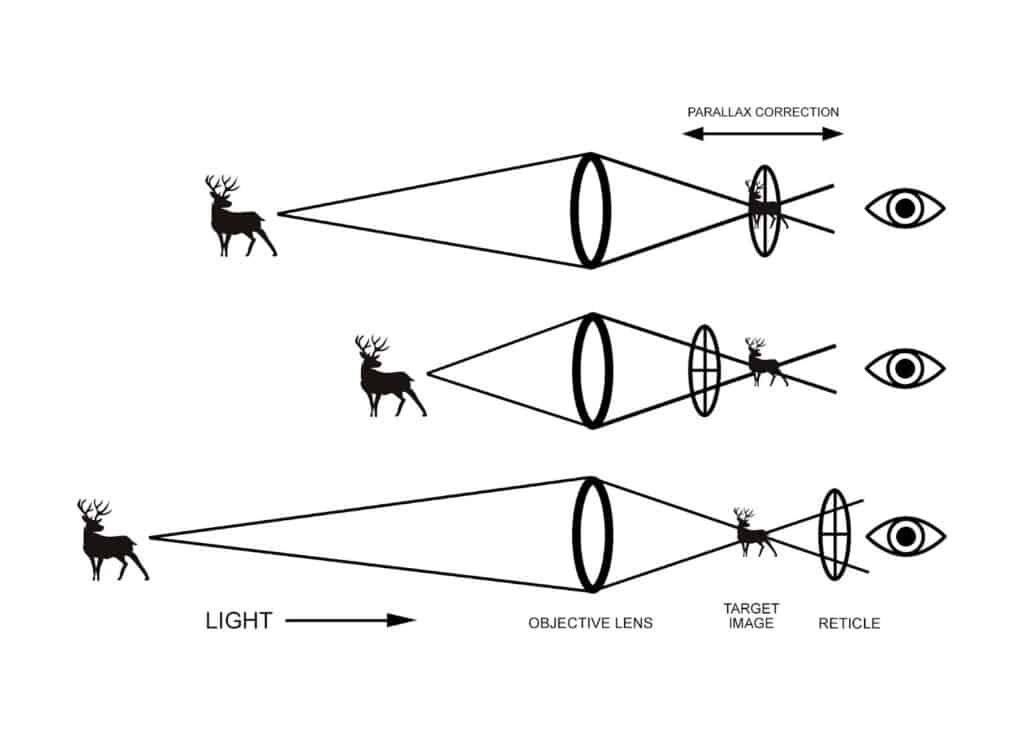Rifle scopes are essential accessories for any hunter or shooter looking to improve their accuracy and precision. These devices allow the user to aim and shoot with greater accuracy and consistency, making them an indispensable tool for anyone who wants to take their shooting game to the next level.
While there are many factors to consider when selecting a riflescope, the weight of the sight should not be overlooked. A heavier riflescope can impact accuracy, comfort, and mobility, and it can make it challenging to use for extended periods. Therefore, understanding the factors that affect and determine the weight of a scope is essential to making an informed choice when selecting one for your rifle.

This article will explore the factors influencing riflescope weight, including magnification, objective lens size, reticle type, materials, and additional features. Let’s get into detail!
Rifle scope weight: what to consider
Magnification
Magnification is the ability of a scope to enlarge the image of a target. Generally, a higher magnification results in a larger and clearer target image. However, the higher the magnification, the heavier the rifle scope. This is because a scope with a higher magnification is usually made with more internal components that add to the overall weight.
For example, a rifle scope with a variable power scope of 4x- 12x will definitely be a little lighter than a variable power scope with a magnification range of 5x – 25x. The 4x- 12x scope might have a compact design with a smaller objective lens, while a 5x – 25x scope would require a larger objective lens and more internal components to provide a clear image at that magnification level.
It’s important to balance the desired magnification level with the weight of the scope to ensure that it is comfortable and easy to use for extended periods. Most newbies and gun enthusiasts usually go for a scope with a higher magnification, but that is not necessary because a higher magnification will only be a burden if you do not get to use it. For instance, if a hunter has most of his game between 100 yards and 150 yards, it would be a total waste if the hunter gets a riflescope that has a 5x- 25x magnification. A scope with a lower magnification range of 4x- 12x would do the job excellently.
In general, choosing the lowest magnification that will still provide a clear and accurate image of the target is highly recommended, as this will typically result in a lighter and more manageable rifle scope.
Objective Lens Size
The objective lens is the lens located at the front of the scope that gathers light and creates the image of the target. The size of the objective lens is an important factor because it affects the amount of light that enters the scope and the size and clarity of the image.
Larger objective lenses allow more light to enter the scope, resulting in a brighter and clearer image, particularly in low-light conditions. However, larger objective lenses also add weight to the scope. This is because a larger lens requires more glass and materials to construct, increasing the scope’s overall weight.
For example, a scope with a 32mm objective lens diameter will typically be lighter than a scope with a 50mm objective lens diameter. This is because the 50mm lens will use more materials during construction and weigh more in the end.
When choosing a scope, it is essential to consider the trade-off between the size of the objective lens and the scope’s weight. Larger objective lenses are beneficial in low-light conditions and can provide a clearer image, but they will also add weight to the scope. Therefore, you must choose an objective lens size that meets your specific needs while still keeping the overall weight of the scope in check.
Reticle Type

The reticle is the pattern or design in the scope’s eyepiece that helps the user accurately aim at the target. Reticles can come in various shapes and sizes, including crosshairs, dots, and other designs.
The type of reticle used in a scope can affect its weight. For example, reticles with a more intricate design or multiple lines may require additional materials to construct and be heavier than a simple crosshair design. Similarly, illuminated reticles, which use battery-powered LED lights to illuminate the reticle, will be heavier than non-illuminated designs.
It’s a good idea to consider the type of reticle when selecting a scope, as it can impact both the weight and the user’s accuracy. While some users may prefer a more complex or illuminated reticle design for its added features, others may prefer a simpler design for its lighter weight and ease of use.
Therefore, when selecting a scope, assess your shooting needs and choose a reticle type that will best suit your requirements while still keeping the weight of the scope manageable.
Materials
The materials used in the construction of a scope can significantly impact its weight. Generally, more durable and high-quality materials will add weight to the scope, while lighter materials may be less durable and may not offer the same level of performance.
For example, scopes made with aluminum or titanium may be heavier than scopes made with polymer or composite materials. Similarly, a high-end glass used in the lenses will be heavier than lower-quality glass.
When selecting a scope, you must look at the materials used in its construction, as this can impact both the weight and the overall quality and durability of the scope. While lighter scopes may be more comfortable to use, they may lack the expected level of performance or durability, but heavier scopes will most likely be durable.
Tube Diameter
The tube diameter is the size of the scope’s main body or housing. A larger diameter tube typically provides more internal space for the lenses and other components, which can improve the scope’s overall performance. However, a larger tube also means more materials are required to construct the scope, which results in a heavier weight. The most common tube diameter size for a riflescope includes; 1-inch scope and a 30mm scope, with some higher-end models having even larger tube diameters like 34mm. The 30mm scope is the most common among them.
Turret Type
The turret is the mechanism on top of the scope that allows the shooter to adjust the point of impact. A rifle scope usually has an elevation turret and a windage turret. The elevation turret is used for adjusting the reticle vertically, while the windage turret can adjust the reticle horizontally. There are two main types of turrets: capped and uncapped turrets. Capped turrets are covered and require the shooter to lift the cap to adjust the point of impact. Uncapped turrets are exposed and allow the shooter to make adjustments without removing a cap. Capped turrets are generally heavier than exposed turrets because the cap adds some extra weight to the scope.
Coatings
Coatings are applied to the scope’s lenses to improve light transmission, reduce glare, and protect the lens from scratches and other damage. The number and type of coatings used can impact the weight of the scope. More lens coating generally means better performance, but they also add little weight. High-quality coatings can significantly increase the price of a rifle scope, but they can also significantly affect the scope’s overall performance.
Model
The brand and model of a rifle scope can also affect its weight. Different manufacturers use different materials and designs, resulting in variations in weight and overall performance. Higher-end models may use premium materials and have more features, which can add to the weight of the scope.
Additional Features
In addition to the factors discussed above, there are several other features and accessories that can affect the weight of a rifle scope. These features can vary greatly depending on the specific model and brand of scope, and it’s important to consider them when choosing a scope that meets your needs and preferences.
Illuminated Reticles
Illuminated reticles are designed to improve visibility in low-light conditions by providing additional lighting to the reticle. However, the additional components required to provide illumination can add weight to the scope.
Parallax Adjustment

Parallax adjustment is a feature that allows the shooter to adjust the focus of the reticle to reduce the effect of parallax error. While parallax adjustment can be a useful feature for improving accuracy, it often adds weight to the scope.
Zero Stop
A zero stop is a feature that allows the shooter to quickly return the scope to a pre-set zero point. This can be especially useful for long range shooting, but it also adds weight to the scope.
Throw Lever
A throw lever is a small lever that attaches to the magnification ring of the scope, allowing the shooter to quickly and easily adjust the magnification. While a throw lever can be a useful accessory, it also adds weight to the scope.
Lens Covers
Lens covers are accessories that protect the lenses of the scope from scratches, dirt, and other damage. While lens covers are relatively lightweight, they do add some additional weight to the overall setup.

Mike Hardesty is a published freelance gun writer. He also possesses specialized expertise in rifle scopes With dozens of articles and reviews published in Pew Pew Tactical, Snipercountry.com, and TTAG (The Truth About Guns), Mike is considered a firearms expert. His special area of expertise is handguns.
Mike is a long-time shooter. He has been punching paper targets, taking deer and other game and shooting at competitions since about 1975. Other related pursuits include reloading and bullet casting. He currently reloads for over 10 calibers, both handgun and rifle. His reloads, particularly for 9mm, were in great demand during the height of the ammo shortage among family and friends. He donated hundreds of rounds to informal shooting sessions. He was quoted as saying “I do not sell my reloads but I sure will help my guys shoot ’em for free!”. He has a few cherished firearms that he has inherited or otherwise procured — those are his favorites.
He earned B.S. and M.S. degrees from Indiana State University in 1974-1975.
He’s a firearm experts and is the founder of mhardesty.com.
